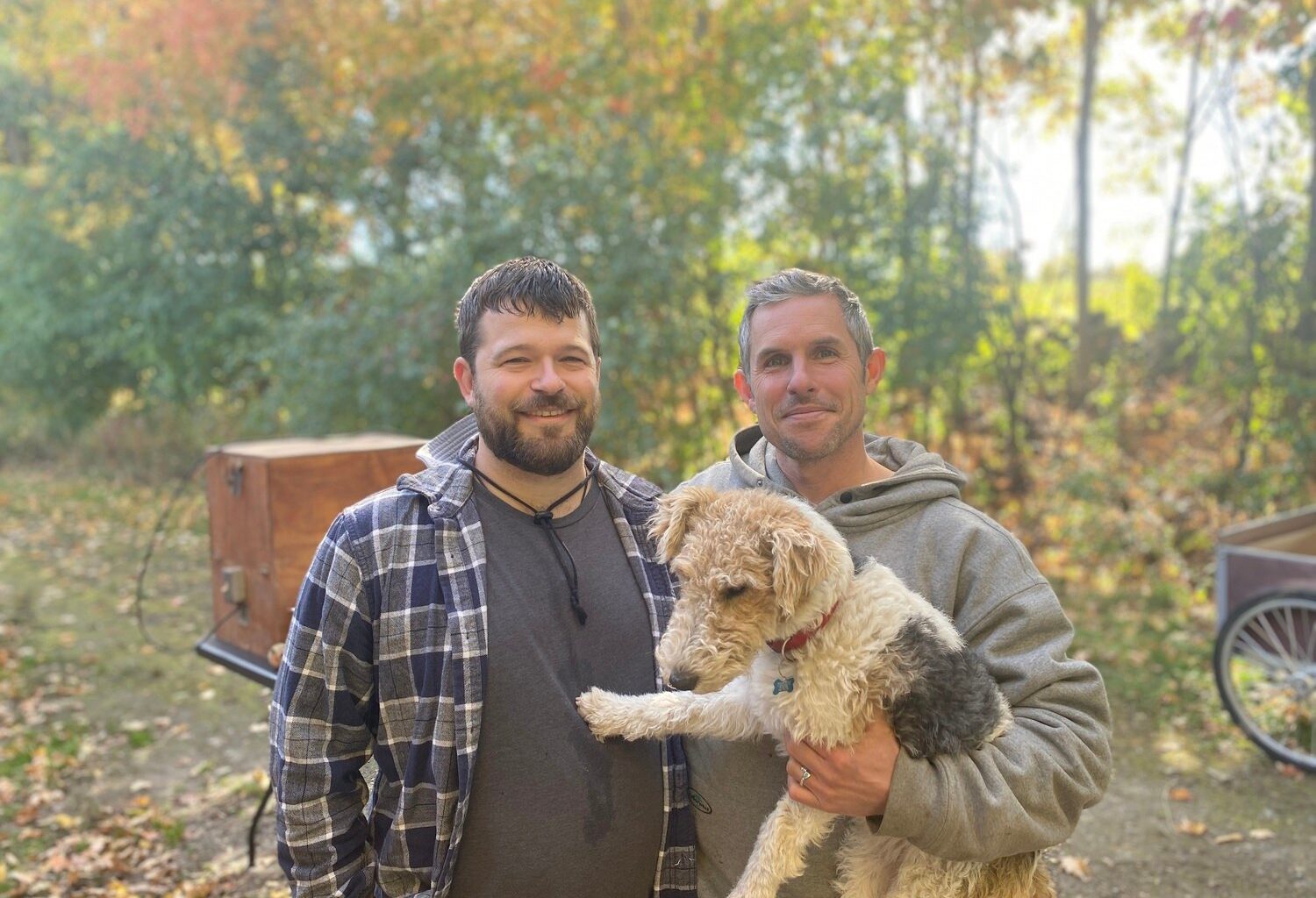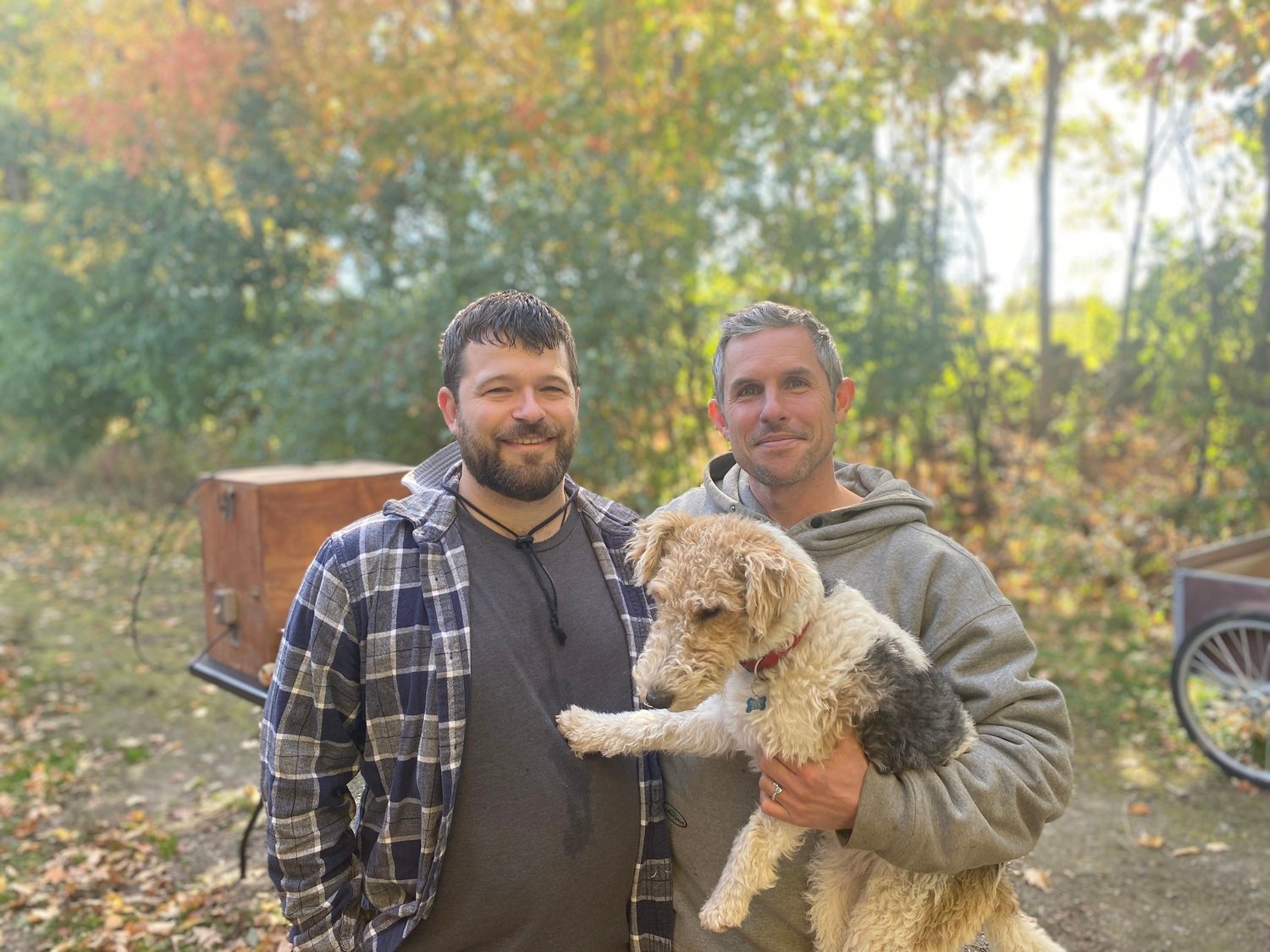Connor Mackay (left) and Adam Wilson (right) are the main caretakers of Sand River Community farm in Keeseville, which hosts weekly lunches and suppers for locals. Photo by David Escobar
David EscobarThe Adirondack farm where nothing is ever sold
Driving down Mace Chasm Road in Keeseville, Sand River Community Farm is easy to miss. A small wrought-iron sign marks the entrance, leading down a dirt road to an old farmhouse tucked among black walnut trees.
On a recent Sunday afternoon, about 10 people were scattered across the property. They dug up potatoes in the field, peeled garlic on a workbench and prepared a fall vegetable stew at an outdoor stove in preparation for the farm’s weekly “Sunday Supper.”
Outside a storage shed, Connor Mackay split and stacked firewood for the farm’s bread oven. Since moving to Au Sable Forks this summer, he has worked at Sand River almost every day: harvesting vegetables, milking cows, and rotating paddock fences for sheep. Like everyone at the farm, he does not earn a wage for his work.
“I don’t even think of it as volunteer work,” Mackay said. “It just feels like the right thing to do.”
Adam Wilson harvests turnips at Sand River Community Farm in Keeseville. Photo by David Escobar
A different kind of farm
Sand River Community Farm, which sits atop a sandy hill adjacent to the Ausable River, looks like any other small Adirondack farm, with livestock, vegetable gardens and a weathered barn. But none of its food ends up for sale in grocery stores or a farmers’ market.
Instead of full-time employees, the nonprofit farm is run entirely by members of the local community. It is not a cooperative, and volunteers do not earn shares, wages, or even produce in exchange for their labor.
Instead, every vegetable, frozen container of soup and parcel of meat produced by the farm’s workers are offered as a gift to anyone in the community.
For Mackay, the farm challenges the idea that agriculture must be transactional.
“The people that do get connected to this place, it lands a seed in them, or ignites a little spark,” he said. “It just shows you a new way you could go about living.”
That spark is what drives Adam Wilson, the farm’s caretaker. Before starting Sand River, Wilson ran a traditional farm business in Vermont. During the pandemic, he began experimenting with something new: a small farmstand where neighbors could exchange gifts instead of money, dropping off cartons of eggs or vegetables and leaving with a loaf of bread.
“The way people responded to farming once it was no longer a business was just so different,” Wilson said. “It opened up something for people that I hadn’t seen in my days as a business owner.”
Wilson said the experiment worked, but he still did not have a permanent home for his project. A few years later, a donor offered Wilson around half a million dollars to put the idea on more permanent ground. The funds were placed in a trust and used to purchase a long-abandoned farmhouse in Keeseville, which Wilson transformed into Sand River Community Farm.
Read some of Adam Wilson’s essays about Sand River Community Farm on his Substack
That gift turned an idea into a functioning community farm. But Wilson said keeping the project sustainable is an ongoing challenge.
“People do like to make the project into a victory story, like we’ve figured out how to grow and distribute food outside of capitalism,” Wilson said. “And that’s mostly not what it looks like from behind the scenes. It looks like a whole lot of humbling and a whole lot of learning.”
At Sand River Community Farm, Adam Wilson and Connor Mackay tend to livestock, including dairy cows and oxen that are being trained to plow the soil. Photo by David Escobar
“Neighborly farming”
Throughout the year, Sand River’s stewards raise cows and sheep to help fertilize the sandy soil and make vegetable farming possible. Since nothing is sold, the farm depends on the community’s time and effort through weekly “Farm Frolics,” when locals come together to do chores and share in the day’s work.
During the fall, volunteers hurry to harvest and process root vegetables and grains before they spoil. On a recent afternoon, Doliah Francis shelled red and yellow corn kernels to dry and store for the winter.
Francis began helping out in the spring, drawn to the farm’s mission and the chance to work the land. She said she soon realized the farm represented something deeper: an older, more communal way of living that predates commercial agriculture.
“Our communities got by and were ran through relational living with one another,” Francis said. “The point of Sand River is to remind us there’s a way to live outside of money, where we’re actually just helping and taking care of each other, because we’re human beings, and that’s what we’ve always done.”
Will Wilson (left) and Doliah Francis (right) shell kernels off corn cobs at Sand River Community Farm in Keeseville. Photo by David Escobar.
CJ Dates, a regular volunteer and member of the farm’s “visionary board,” said Sand River’s mission can seem radical in a world built around production and profit.
“It flies in the face of this idea that farming has to be about creating a product at the best possible price or the fastest possible way,” Dates said. “I really see it as a method of organizing people in a way that heals relationships and also connects them to each other, the land and their food production.
A shared table
As the workday wound down, a bell tolled from the farmhouse. Volunteers and neighbors gathered around a long table set for a family-style dinner. Before eating, they joined hands in a brief blessing recited before every meal.
Community members gather inside the barn at Sand River Community Farm for a Gratitude Feast. Photo courtesy Adam Wilson/The Peasantry School Newsletter
For Wilson, these moments capture what Sand River is trying to grow: a space where food is both nourishment and offering.
“When this farm is really singing its song, what happens for someone who attends one of the events here is that they get to take a break for a couple of hours from the scarcity of our time,” said Wilson. “They encounter a quality of kindness and hospitality, a sense of welcome that is being articulated by human beings who are here.”
David Escobar is a Report For America Corps Member. He reports on diversity issues in the Adirondacks through a partnership between North Country Public Radio and Adirondack Explorer.






